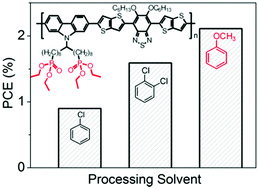Phosphonated conjugated polymers for polymer solar cells with a non-halogenated solvent process
Abstract
Normal photovoltaic polymers must be processed with halogenated solvents, which are harmful to the environment and cannot be used for the mass production of polymer solar cells (PSCs). We report a novel approach to develop photovoltaic polymers suitable for non-halogenated solvent processing by attaching a polar and inert phosphonate moiety to the side chain of conventional photovoltaic polymers. The pendant phosphonate moiety does not obviously affect the electronic structure of the conjugated polymer backbone but greatly changes the solubility of the polymers. The phosphonated polymers are soluble in several polar non-halogenated solvents, such as methoxybenzene (MOB), methylbenzoate (MBz), o-dimethoxybenzene (o-DMOB), etc. PSCs of the phosphonated polymers processed with MOB exhibit better photovoltaic performances than those of the devices processed with common halogenated solvents. A power conversion efficiency (PCE) of 2.11% is achieved with the device processed with MOB, in comparison to the PCE of 0.90% with chlorobenzene (CB) as the processing solvent and the PCE of 1.59% with o-dichlorobenzene (o-DCB) as the processing solvent. These results indicate that a pendant phosphonate moiety is an effective approach to developing photovoltaic polymers towards the production of PSCs fabricated using environmentally friendly solvents.


 Please wait while we load your content...
Please wait while we load your content...